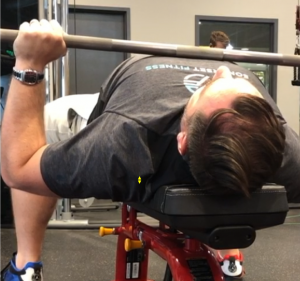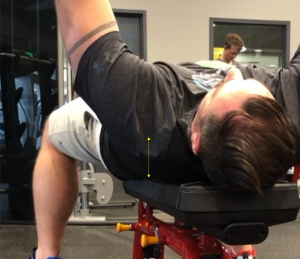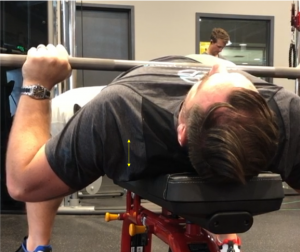Mind the Gap: Improving Pressing Stability with A Simple Cue
A common technique issue I see when working with clients looking to get their pressing strength up is movement of the shoulder blade and humerus during the press phase of the lift. Essentially, they may start off with everything in the right places, but then at the top of the movement they wind up pressing the shoulder blades up and into the lift, versus just straightening the elbows. This winds up creating a gap between the upper part of the humerus and the bench, which then leaves the arm essentially floating in space and relying on the rotator cuff to hold the fort down. You can see the gap on the following pics with the little yellow line indicating the distance from the humeral head to the bench.

Starts off good

Still looks okay

Aaaaaaaand there is goes
Essentially, the shoulder is now like Drake, in that it started from the bottom and now it’s here.

Why is this gap a challenge? For one, there’s next to no bone on bone contact for the shoulder in this position, as the axis of loading is pushing the humerus back in the shoulder socket, and the only thing keeping it from sliding out is the rotator cuff, the joint capsule, and key working muscles. They’re usually up to the task, but it’s a lot to ask when you’re trying to get your swole on.
Second, If the shoulders were set and back on rep one, then you pressed them out at the top of that rep, your shoulder blades are now out of position for the next rep, which means you’ll have to find a way to retract them under you again, while maintaining the weight over your build. If you don’t manage to retract them, you’re now out of position for the lift you’re looking to do, and the newly protracted position is likely to cause some wonky anterior glide from the humerus at the bottom of the next rep.

Yikes
Now, can you still press with your scaps shrugged out? Sure, but it’s likely to lead to either less than desirable muscle activity from the prime muscles you’re trying to work, and way more pressure and irritation to other stuff that isn’t going to benefit you, so it might be worth doing it right and not having to try to reverse engineer your set up from a poor position.
So how do we go about getting set and staying set? It’s a surprising amount of work from the upper back muscles to pull the shoulders tight enough under the ribs to hold, but the cue I use is to try to get the upper arm bones to physically touch the bench. You’re trying to close the gap. This takes a lot of thoracic extension and scapular retraction mobility, so you have to have enough to get into position, which a lot of people may struggle with.
Once you have the shoulders in the position where the arm is in contact with the bench, your goal is to keep them in contact throughout the entire rep range, and the entire set. I guess you can let them go a bit when you’re going to re rack the weight, but at that point you can do whatever you want short of dropping the weight on your own face.
Is this hard to do? You bet. But no one ever said getting jacked and awesome at benching would be easy. In fact, the easiest part of bench pressing is the pressing. Everything else sucks, but when it goes right you can likely hear unicorns signing.